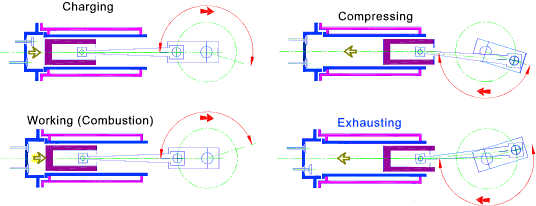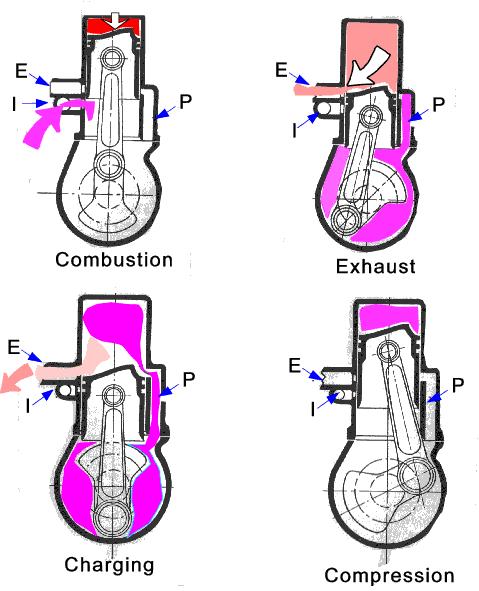Introduction
Petrol, paraffin, gas and oil internal combustion engines generally work on four-stroke
or two stroke cycles. The four stroke completes one engine cycle for every
four strokes of the piston, that is every two revolutions of the crankshaft. The two stroke completes one engine cycle for every
two strokes of the piston, that is each revolution of the crankshaft. Engines
mechanisms working on either cycle can be designed for spark-ignition or compression ignition (diesel)
as the method of initiating combustion according to the engine speed, size, and type of fuel
used.
Four Stroke Engines
In essence in a four stroke internal-combustion engine an explosive mixture is drawn
into the cylinder on the first stroke,it is compressed and ignited on the second stroke;
work is done on the third stroke and the products of combustion are exhausted on the fourth stroke.

Spark ignition cycle...(otto cycle)
- The inlet valve is open prior to commencement of the first stroke
- In the first stroke (charging) the piston moves out and the cylinder air-fuel is drawn into the cylinder
- The inlet valve is closed
- In the second stroke (compression) the piston compresses the mixture.
- At the end of the compression stroke the fuel-air mixture is ignited by a spark
- The third stroke - the working/power stroke results from the hot products of combustion expanding driving the piston out
- At the end of the power stroke the exhaust valve is opened.
- The fourth stroke is the exhaust stroke when the products of combustion are driven out of the cylinder
|
Note: The motion of the piston during the charging, compression and exhaust strokes is driven
by the inertia of the a flywheel which is used to ensure smooth continuous motion.
Compression ignition cycle...(diesal cycle)
- The inlet valve is open prior to commencement of the first stroke
- In the first stroke (charging) the piston moves out and the cylinder air is drawn into the cylinder
- The inlet valve is closed
- In the second stroke (compression) the piston compresses the mixture.
- At the end of the compression stroke the fuel is injected into the air which has been compressed to high pressure and temperature above the flash point of the fuel. Spontaneous combustion occurs
- The third stroke - the working/power stroke results from the hot products of combustion expanding driving the piston out
- At the end of the power stroke the exhaust valve is opened.
- The fourth stroke is the exhaust stroke when the products of combustion are driven out of the cylinder
|
Notes on the theoretical consideration of the otto and deisel cycles are found on
page Thermodynamic cycles
Two Stroke Engines
Two stroke engines are used for motor cycles,lawn mowers, chain saws and marine engines.

Operating Principles
In the combustion phase an ignited charge exerts pressure on the piston crown whilst a
fresh charge is drawn through the carburettor into the crankcase via inlet port I.
During the exhausting phase the piston moving down partly uncovers the exhaust port E
allow the combustion gases to start to discharge. The downward movement of the
piston also compresses the fuel air mixture in the crankcase.
At the end of the first stroke the exhaust port are fully open and the fuel inlet port P is now open allow
the compressed fuel mixture to enter the cylinder above the piston. The piston crown
is so shaped that the mixture is deflected upwards above the residue of the escaping exhaust gases.
The fuel mixture helps to sweep out the exhaust gases.
During the upward compressing stroke, the piston covers the transfer ports , compresses the charge and creates
a small vacuum in the crankcase. At the end of the upward stroke (inner dead centre) ignition
occurs resulting in the ignited charge expanding and exerting pressure on the piston.
....More notes to follow....
|

